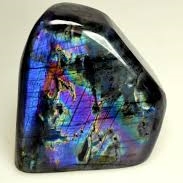Spectrolite: Gemstone Information
Introduction to Spectrolite:
Spectrolite is a rare and stunning variety of labradorite, known for its captivating display of iridescent colors. It was first discovered in Finland in the 1940s and has since become highly sought after by collectors and gem enthusiasts worldwide. Spectrolite’s mesmerizing play of colors, ranging from vibrant blues and greens to fiery oranges and reds, makes it a prized gemstone for jewelry and decorative items.
Physical Properties:
Spectrolite is a type of feldspar mineral, belonging to the same family as labradorite. It typically exhibits a dark base color, often black or gray, with flashes of intense spectral colors when viewed from different angles. These iridescent colors are caused by the scattering of light within the mineral’s internal structure, known as labradorescence.
Appearance:
The most striking feature of spectrolite is its remarkable iridescence, which sets it apart from other varieties of labradorite. When light strikes the surface of spectrolite at the correct angle, it reflects and refracts within the stone, creating vibrant flashes of color that seem to dance across its surface. These colors can include shades of blue, green, yellow, orange, and red, forming intricate patterns and shapes reminiscent of the Northern Lights.
Metaphysical Properties and Benefits:
Spectrolite is believed to possess various metaphysical properties and benefits, drawing on the energies of labradorite while incorporating its own unique qualities. Some of the potential metaphysical properties and benefits associated with spectrolite include:
Protection and Shielding: Like other varieties of labradorite, spectrolite is thought to provide protection against negative energies and psychic attacks. It is believed to create a barrier of light around the wearer, deflecting harmful influences and promoting a sense of security.
Enhanced Intuition: Spectrolite is associated with stimulating intuition and psychic abilities. It is believed to heighten awareness and perception, allowing individuals to tune into their inner wisdom and guidance.
Emotional Healing: Spectrolite is said to facilitate emotional healing and transformation. It is believed to help release emotional baggage, promote self-discovery, and instill a sense of balance and harmony.
Creativity and Inspiration: Spectrolite’s vibrant colors and dynamic energy are thought to inspire creativity and imagination. It is believed to awaken dormant talents and encourage artistic expression.
Spiritual Growth: Spectrolite is often used in spiritual practices and meditation to deepen one’s connection to the divine. It is believed to open the mind to higher consciousness, facilitate spiritual growth, and align with one’s soul purpose.
How to Use Spectrolite:
There are several ways to harness the energies of spectrolite:
Wearing Jewelry: Spectrolite jewelry, such as rings, pendants, or earrings, allows you to carry its energy with you throughout the day and benefit from its protective and transformative properties.
Meditation: Holding a piece of spectrolite during meditation can enhance your spiritual practice and facilitate deeper states of relaxation and inner exploration.
Placement in the Home: Placing spectrolite specimens or carvings in your home or workspace can help create a harmonious environment and infuse the space with positive energy.
Visualization: Visualizing yourself surrounded by a sphere of spectrolite energy can help you tap into its metaphysical properties and manifest your intentions.
Incorporating into Rituals: Spectrolite can be incorporated into rituals or ceremonies aimed at protection, healing, or spiritual growth, enhancing their effectiveness and potency.
Conclusion:
Spectrolite is a mesmerizing gemstone with both aesthetic beauty and metaphysical significance. Whether admired for its stunning iridescence or valued for its potential spiritual benefits, spectrolite continues to captivate and inspire those who encounter it. By incorporating spectrolite into your life through jewelry, meditation, or home decor, you can tap into its powerful energy and experience its transformative effects firsthand.





